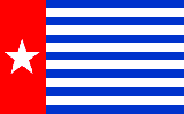A little over 50 years ago when Indonesia annexed West Papua, it was not to liberate the Melanesians from Dutch rule, it was to gain valuable fertile land with considerable mineral and oil wealth and enormous dense tropical rainforests.
West Papua’s mineral wealth includes the
world’s biggest gold mine and the third biggest copper mine. There are over
300,000 cubic metres of Merbu shipped out of the province monthly to China
alone and for the 2008 Olympic Games, China took 800,000 cubic metres of Merbu
worth over US$1 billion.
The destruction of these enormous rainforests is
more likely to be the real reason for the changing weather conditions in
northern Australia, rather than carbon emissions.
In 1960 when the Indonesian government forces
invaded and took over what was to become their biggest province, 97.8 % of the
populations were Melanesians.
But now they make up less than half. The
population is increasing at an incredible rate every year which is a reflection
of the biggest immigration programme ever seen.
The majority of the immigrants come from Java, the
most densely populated island with more than 131 million people, giving it a
density of more than a thousand people to one hectare, compared to Papua’s nine
to a hectare with more than 22% of Indonesia’s land
The Indonesian government in 2003 divided West
Papua into three provinces calling one Papua and another West Papua, which
makes it intentionally confusing, to say the least, and if you visit the
capital of the province Jayapura nowadays you rarely see a Melanesian.
The worry for the rest of the Pacific is
Indonesia’s increasing population and the fact that it has the world’s largest
Muslim population. So unlike China, there will never be a one child programme.
In addition, if the children are still being
taught that Melanesia, Polynesia, Australia and New Zealand are all part of
traditional Indonesia; consequently in forty or fifty years’ time, we could
have a hell of a problem.
Some serious thought should be going into the
possibilities and probabilities of a number of scenarios, bearing in mind other
countries that will most probably be in conflict in the Asian region. The
region that holds more than 53% of the world’s population, and at the same time
remembering that Indonesia is greatly influenced by Islamic Iran and Pakistan.
It is unfortunate, to say the least, that in the
1960s the Western powers were so preoccupied with the threat of Chairman Mao’s
communist China and the domino theory, plus of course the Vietnam War, that not
only the invasion of Papua seemed of less importance but also the murder of PKI
party members and their families throughout Indonesia by Islamic gangs, taking
the lives of an estimated 500,000 people.
We should remember that once again world struggles
could be just as complex and leave all of us vulnerable, but particularly PNG,
which is the other half of the world’s second biggest island. More wars have
been waged and murders committed in the name of religion than for any other
reason. Racial differences add to the vulnerability of some.
—Kevin W. Trueman
Vanuatu
